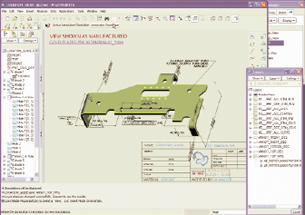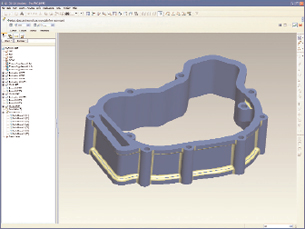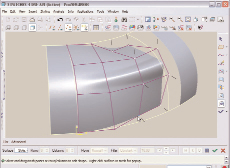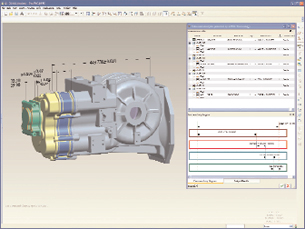Pro/ENGINEER Wildfire 4.0 Delivers Rich New Modeling Tools
This latest version of PTC's time-honored program concentrates on adding power to its design modeling capabilities.
May 1, 2008
By Al Dean
 Pro/E was early out of the gates with support for the AMSE Y14.41 standard for 3D documentation. This continues inWildfire 4 with more control of annotation sets added, and the ability to reuse itwithin MPMLink. |
Since its introduction at the turn of the millennium, Pro/ENGINEER Wildfire releases have undergone extensive system overhaul and while much of the coverage has concentrated on user interface updates, the latest version reveals serious effort made to increase the power of the application. Wildfire 4.0’s functionality is more accessible, new modeling tools have been introduced, and process coverage has expanded. But the first thing a user will notice are additional updates to the interface, so let’s begin there.
From simply opening a model, you’ll see a core level difference. Where search and find tools were spread across several areas in previous releases, all this is now available in a single, clearly arranged dialog, which allows you to quickly locate the data you need.
Within Open Dialog there is also a new tool — Open Representation. This allows you to handle the huge datasets that are increasingly common and to do so efficiently; loading only the data you need. You can open either a predefined representation that might reflect a work zone or subsystem. It also enables you to open an ultra-lightweight version automatically if Pro/E is set to make decisions about what it loads. For example, it will load a pure graphics-based representation (thought to be around 75 percent lighter than a standard Pro/E data file in terms of memory usage) by default. This technology also extends into working with the system. As you load subassemblies and parts, these are swapped in and out of memory as you need them. The active components are fully loaded, but the remainder of the model is grayed out and transparent — making complex subassembly much less ambiguous. What’s important to note is that when you’re done with your modeling task, the system unloads the data and reverts back to the graphics-only representation. This isn’t particularly unique technology, but its introduction into Pro/E is going to be a welcome addition for many users. Other assembly modeling updates include a rework of the fastener-positioning tools. For instance, when you position a bolt, you add the part, then drag and drop the mates to link them and the part snaps into place — very cleverly done.
 The new Auto Round feature automatically applies Rounds to a part or set of geometry. |
Reference Viewer
The new Reference Viewer consolidates a number of existing tools into a single tool for inspecting product structure and the inherently complex parent and child references. It allows you to explore inter-part and inter-assembly relationships to a granular level (down to feature level), which serves a few purposes. If you have a complex product model, a seemingly small change can wreak havoc. With this tool you can graphically see how change propagates through a model and where problems could arise. In many cases, a bit of forethought can save you the sheer pain of having to redo that work if you can see the effects and make an informed decision. Also, the Reference Viewer allows you to break relationships where they need to be broken.
 Wildfire 4 also introduces new Surface editing tools that give you direct control over a surface’scontrol points, isoparms, etc. to create truly complex sculpted forms, with a great deal of control. |
Unrelated Model Replace
Another useful feature for those working with ever-changing assembly models is the Unrelated Model Replace function. While most designers are familiar with working with families of parts and assemblies to create product variants and configurations, many also must build products from seemingly unrelated sub-systems and sub-assemblies — something that’s not particularly applicable to automation. The Unrelated Model Replace function supports this with tools to dynamically swap parts or subassemblies using existing designs. It allows you to break the initial mating and positioning references, then reassign them to the new data (whether native Pro/E or imported third-party geometry). It works on both upstream and downstream (parent or child) relationships and, when combined with the Reference Viewer, makes light work of something that might traditionally be a royal pain in the behind. If it’s an oft-repeated process, then you can standardize it as an Interchange Assembly to automate its reuse.
Sketch-based Feature Workflow
While Pro/E has always had a rich set of sketching tools (in the last few years many of the restrictions to fully defining sketches have been lifted), this release offers greatly improved feedback during the sketching process. For example, most features require a closed loop, so the system will now shade any closed loops it finds in a sketch. Conversely, if you have open ends or overlapping geometry, the system highlights those as well — invaluable if you’re reusing 2D CAD data.
Feedback has been carried through into other areas as well. Now you can use design intent to reference an edge loop, rather than a specific set of entities. Other systems have been doing this for a while; it just makes sense and will save a lot of headaches for those involved in very quick and drastic iterations. This has also made the User Defined Feature tools more intelligent and tolerant to change.
The new Feature Requirements tool provides a series of checks for building features from sketch geometry. While this is unnecessary for simple features, these can get quite complex in many industries. There’s also the new Feature Failure Manager, a really handy tool when features go wrong (and they can, spectacularly). It gives you explicit feedback about the reasons for failure and what you need to fix — rather than leaving you in the dark.
Modeling updates
There are too many updates in the modeling tools to review, but two deserve highlighting: Auto Round and the enhanced Hole Tool. The Auto Round feature — fillet for non-Pro/E folk — is pretty much what you’d expect. It automatically applies rounds to a part or set of geometry. You set up the part, add the inner and outer radii you require, mark exceptions, then apply. While the end result is a single auto-round feature in the history tree, in the background the system is applying each round, grouping, and reordering them to meet your requirements. This isn’t unique technology (SolidWorks and CATIA have it), but it saves you a whole lot of time. If you subsequently want to have separate fillet features in your tree, you can explode the Auto Round feature and it will swap it out with a list of explicit features for each that you can edit (it’s a one-time process, there’s no going back).
Of late, Pro/E made increasing use of drag handles, but it can sometimes lead to a slightly confusing situation with specific features like holes. These are now color coded, so you can see exactly what you are changing. On a more functional note, you can now represent drilled holes (rather than just flat-bottomed holes as before) and, if you’ll forgive the horrendous but irresistible pun, the whole process is much more dynamic.
 Although not detailed in the review, the new Tolerance analysis system allows you to gauge theeffect of manufacturing variation on your part’s geometry and quality. |
Drawings
Again, as with any release, there are many small updates to the drawing and drafting tools in Pro/ENGINEER, but if there is a single big push, it’s in the area of 3D annotation. PTC was pretty early out of the gate with support of the AMSE Y14.41 standard (and subsequent British and ISO standards). In version 4.0 that work continues with more control of annotation sets; you can now extract that information and reuse it within MPMLink — PTC’s new Manufacturing Process Management module for Windchill.
What Pro/E Can Do
While I’ve discussed the core tools applicable to every user, this review barely covers what PTC is doing with Pro/E. There’s as much in Wildfire 4.0 content among the various add-ons, modules, and other products. What’s interesting is that at a basic level, developers seem to have taken stock in what causes users pain and have worked to ease those pain points by letting the user work more efficiently and in a more informed manner.
Pro/ENGINEER, however, is 20 years old and in some areas it shows. I can understand the rationale behind leaving some things as they always have been, but the fact remains that the entire system hasn’t yet moved to the new Wildfire interface. And while I feel it’s time to bite the bullet and update everything, Pro/ENGINEER Wildfire 4.0 is an incredibly rich application, and one that’s still growing. It’s not the most visually compelling system, but there’s very little that a fully loaded seat of Pro/E can’t do from basic part modeling to complex surface definition and beyond.
If you’re an existing 3D user, chances are you’ve come across Pro/E and it’s worth exploring as an alternative. If you’re a 2D user looking to move to 3D, then Wildfire 4.0 should be on your list of candidates — there’s a lot here to sink your teeth into.
More Info:
Pro/ENGINEER Wildfire 4.0
PTC
Needham, MA
Contributing Editor Al Dean is the former technology editor at MCAD Magazine, a UK product development and manufacturing technology journal, and is working on a number of projects that launch later this year. You can send comments about this article to [email protected].
Subscribe to our FREE magazine, FREE email newsletters or both!
About the Author
DE’s editors contribute news and new product announcements to Digital Engineering.
Press releases may be sent to them via [email protected].






